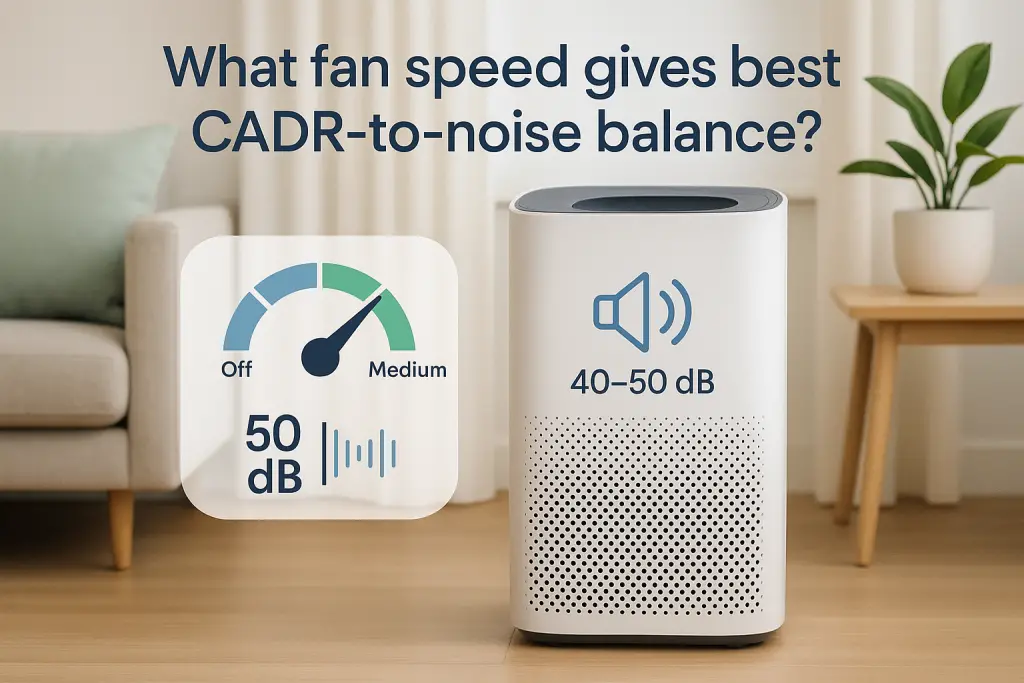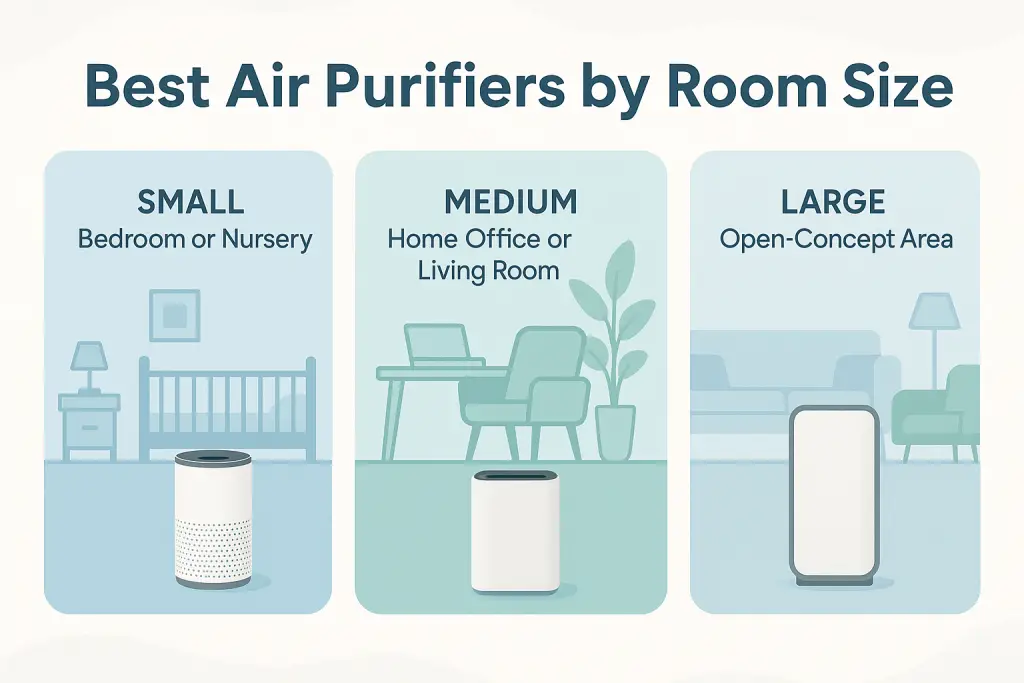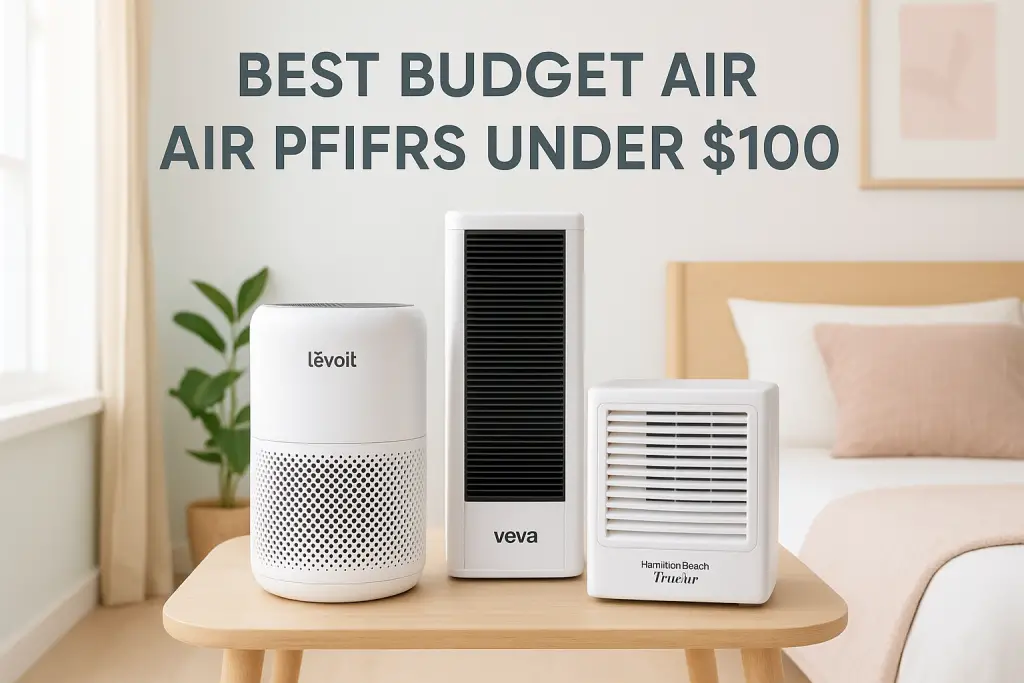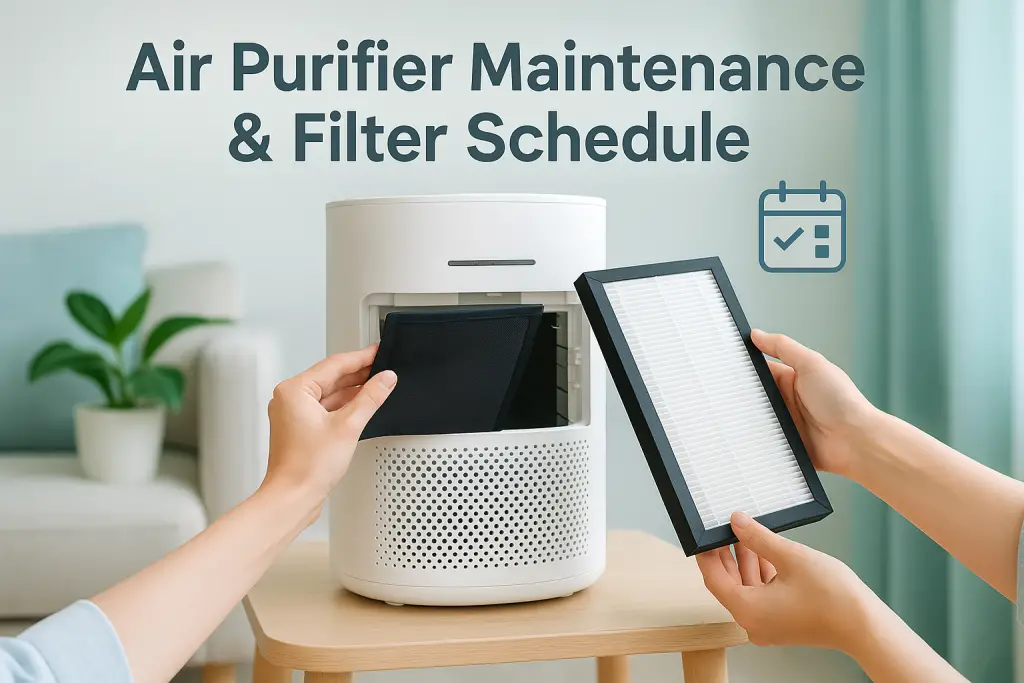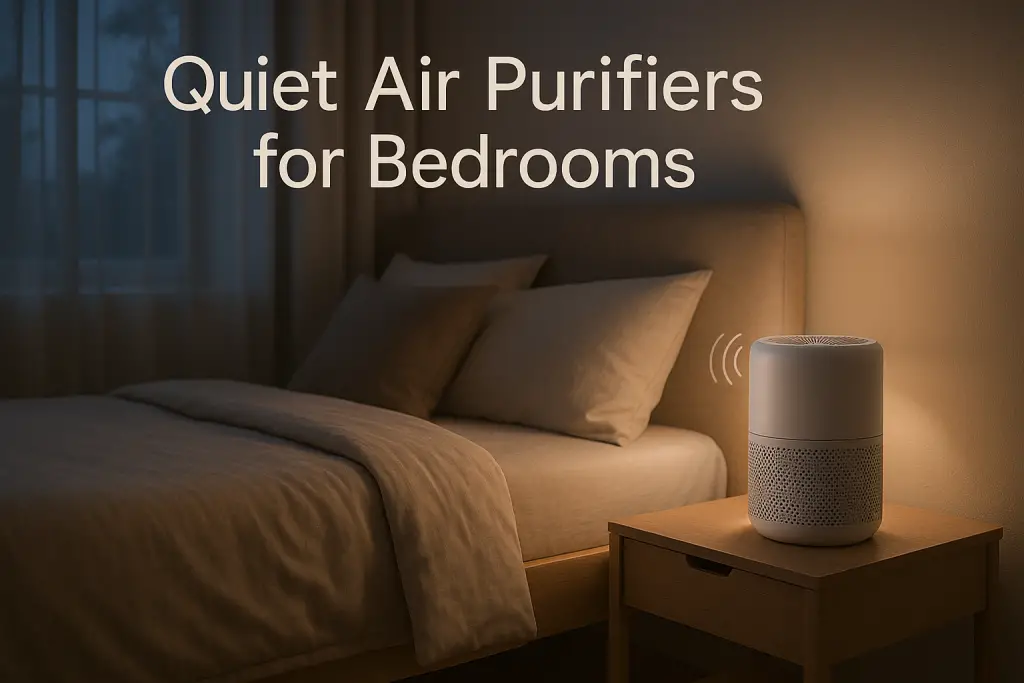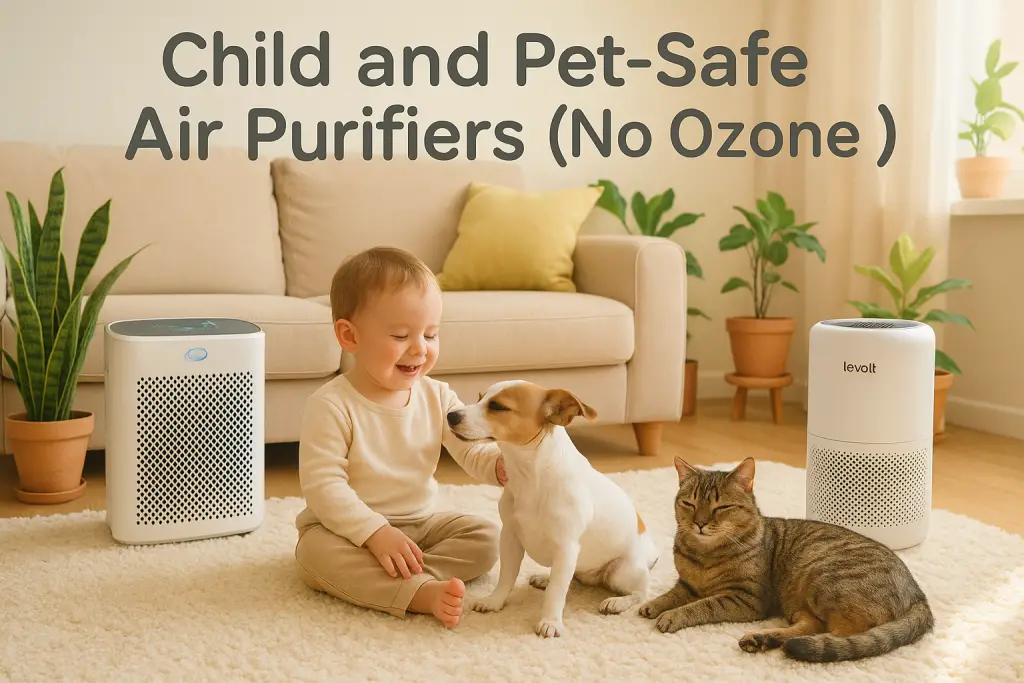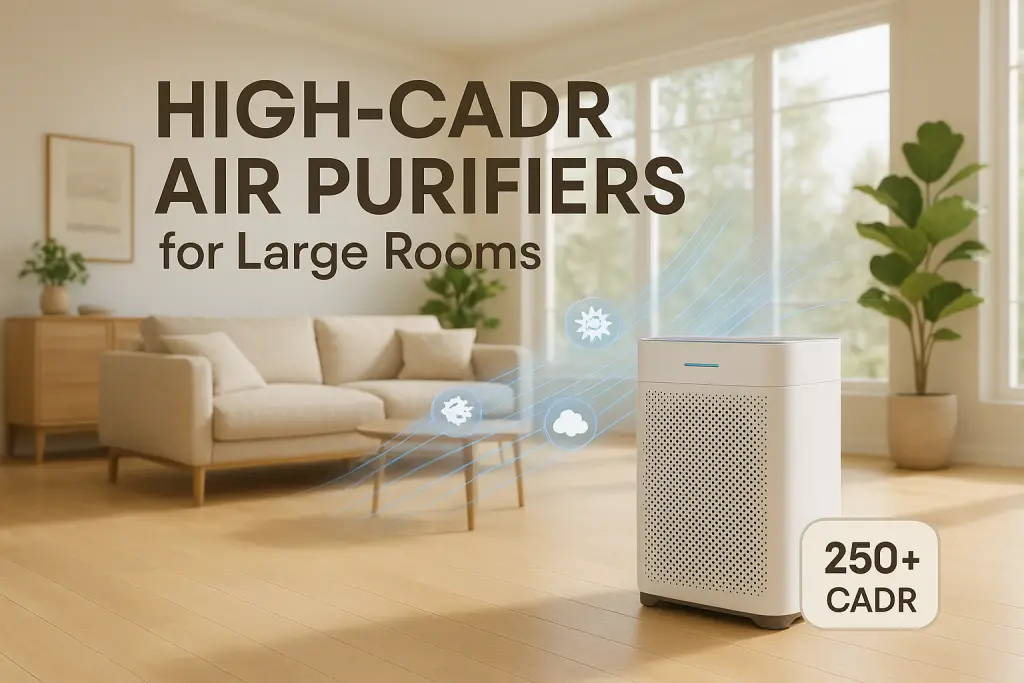Medium speed typically offers the best CADR-to-noise balance for most air purifiers. This setting delivers about 60-70% of maximum air cleaning power while keeping noise at comfortable levels (40-50 dB). The perfect balance point varies based on room size, air quality needs, and personal sensitivity to sound. For optimal results, consider both your specific situation and your air purifier’s technology when selecting fan speed.
Understanding the CADR-to-Noise Relationship
Before determining the optimal fan speed for your air purifier, it’s essential to understand what CADR is and how it relates to noise levels. Clean Air Delivery Rate (CADR) measures how quickly an air purifier filters specific pollutants from the air. The Association of Home Appliance Manufacturers (AHAM) certifies these ratings, which typically cover dust, pollen, and smoke removal capabilities.
CADR values directly correlate with fan speed – higher speeds move more air through filters, capturing more pollutants. However, this increased air cleaning power comes with a trade-off: noise. As fan speed increases, so does sound output, measured in decibels (dB).
This relationship creates a balance challenge. You want maximum air cleaning but minimum noise disruption. For people with respiratory conditions like allergies and asthma, finding this balance becomes even more crucial – you need effective air cleaning without the stress of excessive noise.
How CADR Changes Across Fan Speed Settings
Air purifiers typically lose a significant percentage of their CADR when operated at lower speeds, but the relationship isn’t always linear. Understanding these changes helps you make informed decisions about which setting works best for your needs.
Here’s how CADR typically scales across fan speeds:
- High Speed: 100% of rated CADR
- Medium Speed: 60-70% of rated CADR
- Low Speed: 30-40% of rated CADR
This variation means a purifier with a 300 CADR rating on high might only deliver 180-210 CADR on medium and 90-120 CADR on low. Manufacturer specifications rarely detail this relationship, making it difficult for consumers to understand the performance trade-offs at different settings.
Noise Levels at Different Fan Speeds
While CADR decreases at lower fan speeds, so does noise – but understanding the specific decibel levels can help you make informed decisions about which setting is right for different situations.
Typical noise levels across fan speeds:
- High Speed: 50-60 dB (similar to normal conversation)
- Medium Speed: 40-50 dB (like a quiet office)
- Low Speed: 30-40 dB (like a whispered conversation)
These numbers provide context, but they don’t tell the whole story. The frequency profile of noise matters too – some units produce lower-pitched sounds that feel less intrusive than higher-pitched whines at the same decibel level. Room acoustics also play a significant role in perceived noise. Hard surfaces amplify sound, while soft furnishings absorb it.
The Science of Finding the Optimal Fan Speed
Finding the perfect balance between air cleaning effectiveness and noise isn’t just about comfort – it’s supported by scientific principles. The relationship between fan speed, CADR, and noise follows a curve with diminishing returns at higher speeds.
Most air purifiers follow this pattern:
- Doubling fan speed increases CADR by about 80-90%
- Doubling fan speed increases noise by about 10-12 dB
This creates a diminishing returns situation. Going from low to medium might increase CADR by 80% while adding just 10 dB of noise – a worthwhile trade-off. But going from medium to high often adds another 10 dB while only gaining 30-40% more cleaning power.
Research shows that for many pollutants, there’s a “sufficient cleaning” threshold. Beyond this point, additional CADR provides minimal health benefits. Finding this sweet spot depends on room size, occupancy, and specific air quality concerns.
The Optimal Fan Speed Formula
While there’s no universal “perfect” setting, you can calculate your optimal fan speed using this approach:
Optimal Speed = (Room Size ÷ Max CADR Rating) × Air Quality Factor × Noise Tolerance Factor
Breaking down each variable:
- Room Size: Area in square feet
- Max CADR Rating: Your purifier’s highest CADR number
- Air Quality Factor: 1.0 for good air, 1.5 for moderate issues, 2.0 for poor air
- Noise Tolerance Factor: 0.7 for noise-sensitive areas, 1.0 for normal settings, 1.3 for areas where noise isn’t a concern
For example, in a 300 sq ft living room with a purifier rated at 200 CADR, moderate air quality issues, and normal noise tolerance:
Optimal Speed = (300 ÷ 200) × 1.5 × 1.0 = 2.25
This result suggests running between medium (2.0) and high (3.0) – likely medium-high if your unit offers it.
Medium Speed: Why It’s Generally the Sweet Spot
Across most air purifier models and brands, medium fan speed consistently emerges as the optimal balance between CADR and noise for everyday use. This “Goldilocks zone” delivers significant air cleaning with acceptable sound levels.
At medium speed, most purifiers deliver 60-70% of their maximum CADR while keeping noise below conversation level (typically 40-50 dB). This means you get most of the benefits without most of the noise.
Medium settings offer other advantages too:
- Energy Efficiency: Uses 30-40% less electricity than high speed
- Extended Filter Life: Filters last 20-50% longer than at high speed
- Balanced Performance: Sufficient for normal daily conditions in most homes
This balance works exceptionally well in open plan living spaces where both air cleaning performance and comfortable sound levels matter for daily activities.
When Medium Speed Isn’t Enough
While medium speed offers the best everyday balance, certain situations demand higher fan speeds despite increased noise:
- Cooking Smoke: Run on high for 30-60 minutes after cooking, especially with high-heat methods
- Wildfire Season: High speed during peak outdoor pollution periods
- Allergy Flare-ups: Increase to high during peak pollen days or dust disturbances
- Initial Cleaning: Run on high for 1-2 hours when first entering a dusty space
- Illness Recovery: Higher settings can help reduce airborne pathogens
When higher speeds are necessary but noise is a concern, try running on high when the room is unoccupied, then reducing to medium when you return. Some users place sound-absorbing materials near their purifiers to reduce noise impact during high-speed operation.
When Lower Speeds May Be Preferable
In some situations, the slight reduction in air cleaning efficiency at lower speeds is worth the significant noise reduction benefits:
- Sleeping Hours: Most people sleep better with purifiers on low or sleep mode
- Background Maintenance: In already clean rooms, low speed maintains good air quality
- Home Offices: During video calls or concentration work when noise disruption matters
- Evening Relaxation: When watching TV or engaging in quiet activities
To compensate for reduced CADR at lower speeds, consider running your purifier for longer periods or positioning it closer to where you spend most time. Many users find that running on low continuously provides better overall results than intermittent high-speed operation.
How Different Air Purifier Technologies Affect the CADR-to-Noise Ratio
Not all air purifiers are created equal when it comes to balancing performance and noise. The underlying technology makes a significant difference in how efficiently they clean air relative to the noise they produce.
Key technology differences include:
- Motor Type: DC motors typically run 30-50% quieter than AC motors at comparable CADR levels. They also allow more precise speed control.
- Fan Design: Bladeless designs often produce less turbulence noise. Curved blade designs can move more air with less noise than flat blades.
- Filter Configuration: 360° intake designs often achieve better CADR-to-noise ratios than single-sided intakes.
- Housing Construction: Models with sound-dampening materials and anti-vibration mounts run quieter.
Recent innovations have focused on improving this balance. Some newer models achieve the same CADR at 5-7 dB lower noise levels compared to older units. Finding this balance between performance and other factors like noise and energy use represents the cutting edge of air purifier design.
Fan Speed Recommendations for Different Scenarios
Your optimal fan speed setting depends on your specific situation and needs. Here’s how to choose the best setting for common scenarios:
Bedroom Settings
- During Sleep: Low or sleep mode (30-40 dB maximum)
- Pre-Bedtime Cleaning: Run on high for 1 hour before sleep, then reduce
- For Allergies: Medium if you can tolerate the noise, or place unit farther from bed
Living Areas
- Daily Maintenance: Medium during active hours
- During Gatherings: High before guests arrive, reduce to low/medium during visit
- TV/Movie Watching: Low to medium depending on your sensitivity
Special Needs
- Allergy Sufferers: Medium as baseline, high during symptom flares or follow specific protocols for allergies and asthma
- Pet Owners: Medium most times, high after vacuuming or when pets are particularly active
- Homes with Smoke: High during and after burning incense or other smoke-producing activities
Remember that these are starting points. Your specific needs, room acoustics, and purifier model will influence the ideal settings for your situation.
How to Test If Your Fan Speed Setting Is Effective
Don’t just trust the manufacturer’s claims or general guidelines. Here’s how to verify your air purifier is effectively cleaning your air at your chosen fan speed:
- Use an Air Quality Monitor: Portable monitors can measure particulate matter before and after running your purifier
- Perform the Dust Test: Disturb dust in a room, then time how long it takes your purifier to clear it at different settings
- Track Allergy Symptoms: Keep a log of symptoms at different fan speeds to find your personal “effective threshold”
- Listen for Changes: If your purifier suddenly sounds different at the same speed setting, it may indicate filter saturation
- Check Filter Discoloration: Faster darkening indicates your setting might not be keeping up with pollution
For noise assessment, use a smartphone decibel meter app to measure actual levels in your space. What manufacturers claim and what you experience can differ based on room acoustics and background noise.
Placement Strategies to Maximize CADR at Lower Speeds
Where you place your air purifier can significantly affect its performance, allowing you to achieve better air cleaning even at lower, quieter fan speeds:
- Clearance Rules: Keep at least 2 feet of open space around all intake sides
- Elevate Small Units: Placing tabletop models 3-4 feet off the ground improves circulation
- Doorway Positioning: For multi-room effect, place near doorways but not directly in them
- Avoid Corners: Corner placement reduces airflow by up to 50%
- Consider Air Currents: Position in the path of existing air movement for extended reach
Strategic placement can compensate for a lower fan speed, allowing you to maintain good air quality while minimizing noise.
Maintenance Factors Affecting the CADR-to-Noise Balance
Even the perfect fan speed setting will become ineffective without proper maintenance. Here’s how upkeep affects both CADR and noise levels:
- Filter Loading: As filters collect particles, airflow decreases by 30-50% while noise increases by 3-5 dB
- Fan Dust Buildup: Dust on fan blades reduces efficiency and increases noise
- Loose Components: Vibrating parts can develop rattles that increase noise without improving performance
Regular maintenance preserves your optimal CADR-to-noise ratio. Follow these practices:
- Vacuum pre-filters monthly (or weekly for high-dust environments)
- Replace filters according to manufacturer schedules
- Clean external surfaces and fan blades (when accessible) quarterly
- Follow proper filter disposal practices to avoid recontamination when changing filters
Auto Modes: Do They Actually Find the Perfect Balance?
Modern air purifiers often feature auto modes that claim to automatically adjust fan speed for optimal performance. But how effective are they really?
Auto mode works by using built-in air quality sensors to detect pollutant levels and adjust fan speed accordingly. In theory, this provides the perfect balance – high speed when needed, low speed when possible.
In practice, the effectiveness varies significantly:
- Pros:
- Responds to changing conditions without manual adjustment
- Can reduce energy consumption by 20-30%
- Prolongs filter life by not running higher than necessary
- Cons:
- Sensor quality varies dramatically between models
- Most only detect particles, missing VOCs and gases
- May cycle speeds frequently, creating noticeable noise fluctuations
- Often too slow to respond to sudden pollution spikes
Testing shows that premium models with high-quality sensors come closest to matching ideal manual adjustments. Budget models with auto modes often miss significant pollution events or overreact to minor changes.
Night Mode and Sleep Settings: Effectiveness Analysis
Sleep modes promise quiet operation for bedrooms, but they make significant compromises in cleaning power. Here’s what you need to know:
Sleep mode typically combines several features:
- Reduced Fan Speed: Usually even lower than standard “low” (25-35% of max CADR)
- Display Dimming: Reducing or eliminating LED lights
- Quieter Operation: 25-35 dB (comparable to a whisper)
The CADR reduction in sleep mode is substantial – often delivering only 20-30% of the purifier’s rated capacity. For a 300 CADR unit, that’s just 60-90 CADR during sleep hours.
For many users, this trade-off is worthwhile for undisturbed sleep. However, those with severe allergies might need to find other solutions, such as using a higher setting in adjacent rooms or improving the unit’s placement to compensate for reduced power.
Special Considerations for Sensitive Individuals
For those with specific sensitivities, finding the right fan speed balance requires additional considerations beyond what works for the average user.
Noise Sensitivity
For individuals with noise sensitivity or sensory processing issues:
- Focus on purifiers with DC motors and advanced noise reduction
- Consider units with “white noise” profiles rather than variable tones
- Use sound-absorbing materials (rugs, curtains) around the purifier
- Try running at higher speeds when away, then lower when present
Respiratory Conditions
For those with asthma, COPD, or severe allergies:
- Prioritize cleaning effectiveness over noise concerns
- Consider multiple units running at medium instead of one at high
- Use higher settings during symptom flares, even if noise is noticeable
- Focus on bedroom air quality with strategic placement
Light Sleepers and Infants
For homes with babies or very light sleepers:
- Run on high for 1-2 hours before bedtime, then reduce to sleep mode
- Place units at least 6-10 feet from sleeping areas
- Consider units with gradual speed changes rather than sudden jumps
Energy Efficiency at Different Fan Speeds
Your fan speed choice significantly impacts energy consumption, which affects both operating costs and environmental impact.
Typical power consumption patterns:
- High Speed: 40-90 watts
- Medium Speed: 20-45 watts
- Low Speed: 5-20 watts
This creates significant differences in operating costs. Running a mid-size purifier 24/7 for a year might cost:
- High Speed: $65-150 annually
- Medium Speed: $35-75 annually
- Low Speed: $10-35 annually
Energy-efficient models with DC motors typically consume 30-50% less power at comparable performance levels. ENERGY STAR certified purifiers must meet specific efficiency standards at all operating speeds.
CADR-to-Noise Comparison Across Popular Air Purifier Models
Not all air purifiers perform equally when it comes to the CADR-to-noise ratio. Here’s how popular models compare at different fan speeds:
| Model | CADR (High/Med/Low) | Noise (High/Med/Low) | CADR-to-Noise Ratio (Med) | Technology |
|---|---|---|---|---|
| Coway AP-1512HH | 246 / 150 / 87 | 53.8 / 43.2 / 24.4 dB | 3.47 | DC Motor |
| Winix 5500-2 | 243 / 160 / 98 | 58 / 47 / 38 dB | 3.40 | PlasmaWave |
| Levoit Core 400S | 260 / 170 / 90 | 52 / 45 / 38 dB | 3.78 | DC Motor |
| BlueAir 211+ | 350 / 200 / 120 | 59 / 49 / 31 dB | 4.08 | HEPASilent |
| Honeywell HPA300 | 320 / 190 / 100 | 62 / 53 / 40 dB | 3.58 | AC Motor |
The CADR-to-noise ratio at medium speed (CADR ÷ decibels) provides a useful comparison metric. Higher values indicate better efficiency at balancing performance and noise. Models with advanced motor technology and innovative fan designs typically score better on this measure.
Newer models from brands like Molekule, Air Doctor, and TruSens are introducing novel approaches to the CADR-noise balance, though their non-standard testing methods make direct comparisons difficult.
Advanced Strategies for Optimizing Your Air Purifier Experience
Beyond basic fan speed selection, these advanced strategies can help you achieve the perfect balance of clean air and peaceful environment:
- Zoned Purification: Use different speed settings in different rooms based on usage patterns and sensitivity
- Seasonal Adjustments: Increase baseline speeds during high pollen seasons or wildfire season
- Smart Home Integration: Connect compatible purifiers to automation systems that adjust speeds based on your home/away status
- Multiple Units Strategy: Two units at medium often outperform one unit at high while creating less concentrated noise
- Pre-filtering: Combine with HVAC filters or window filters to reduce burden on your purifier
- Sound Masking: Use white noise machines or apps to make purifier noise less noticeable
- Time-of-Day Programming: Schedule higher speeds during absence and lower during presence
For the most demanding situations, consider combining approaches. For example, a bedroom setup might include a main purifier on low/medium plus a smaller secondary unit positioned farther away running at medium/high, creating better overall cleaning with distributed, less noticeable noise.
Key Takeaways: Finding Your Perfect CADR-to-Noise Balance
Finding the ideal fan speed for your air purifier is ultimately a personalized decision based on your specific needs, but these principles apply universally:
- Medium Speed Sweet Spot: For most situations, medium speed (40-50 dB) offers the best balance, delivering 60-70% of maximum CADR
- Room-Specific Approach: Match fan speed to the room’s purpose – higher for living areas, lower for bedrooms
- Situational Adjustment: Increase speed during high-pollution events, decrease during noise-sensitive activities
- Placement Matters: Strategic positioning can improve performance at lower, quieter speeds
- Maintenance Impact: Regular filter cleaning/replacement preserves optimal performance
- Technology Differences: DC motors and advanced fan designs offer better CADR-to-noise ratios
Remember to reassess your needs seasonally and as your household changes. The perfect balance point may shift with different health conditions, pollution levels, or lifestyle changes.
For immediate implementation:
- Start with medium speed as your baseline in main living areas
- Test higher and lower settings while monitoring both air quality and noise comfort
- Adjust placement to optimize performance at comfortable noise levels
- Create a maintenance schedule to maintain peak efficiency
- Consider upgrading to models with better CADR-to-noise ratios if your current solution isn’t satisfactory
With these strategies, you’ll find the perfect balance between breathing clean air and enjoying a peaceful environment.
| Photo | Air Purifier Model | Best for | Price |
|---|---|---|---|

|
WINIX A231 Air Purifier | Asthma & Indoor Pollution | Check Price On Amazon |

|
Rabbit Air, A3 SPA-1000N Air Purifier | Pet Dander & Odors | Check Price On Amazon |

|
LEVOIT Air Purifier | Best Overall | Check Price On Amazon |

|
GermGuardian Air Purifier | Cigarette & Cooking Smoke | Check Price On Amazon |

|
Coway Airmega Air Purifier | New-borns | Check Price On Amazon |

|
BLUEAIR Air Purifier | Germ & Virus Control | Check Price On Amazon |
